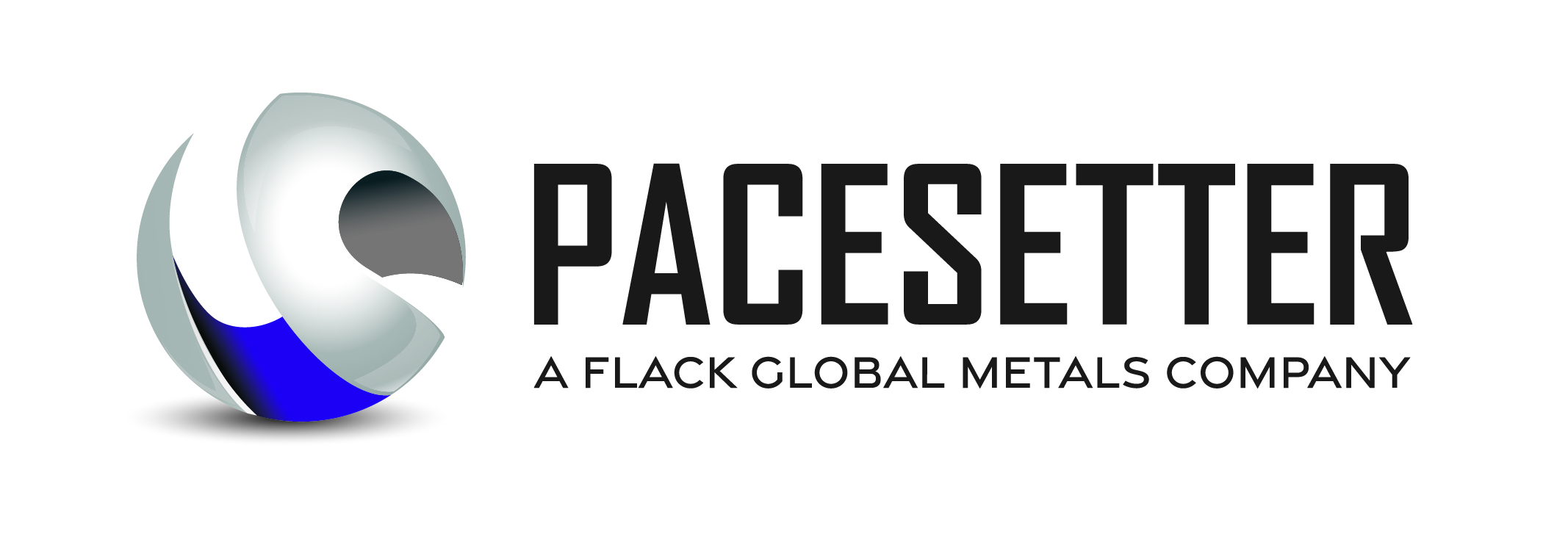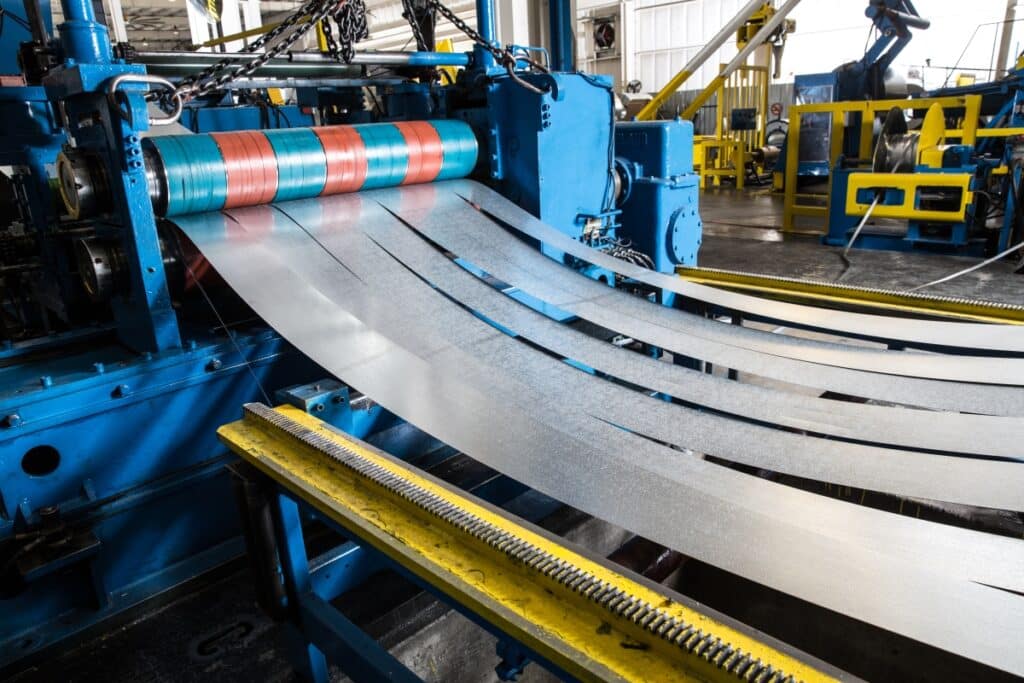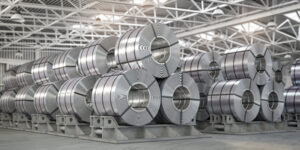Steel Slitting Services
Slitting is an essential part of steel processing. We start with a coil of steel and cut it to the desired length (breaking) and/or width (slitting) for a client’s project. There are various slitting approaches, and it takes a skilled technician to precisely get the job done. We offer slitting services for a variety of steel we supply, including:
- Cold-rolled steel
- Aluminized steel
- Stainless steel
- Galvanized steel
- Galvanneal steel
- Bonderized steel
Many steel manufacturers have challenges executing slitting processing tasks in an efficient manner. Fortunately, Pacesetter offers clients the most comprehensive steel processing services to efficiently and cost-effectively receive the steel they need to meet their project deadlines. We also offer the following steel processing services:blanking, cut-to-length, and toll-processing.
What is Precision Slitting?
Precision slitting is the process of cutting large metal rolls or coils and cutting them into narrower coils or breaking them into smaller coils by weight. The resulting product is still a coil. If a customer needs a steel sheet, then a process such as blanking or cut-to-length would be used.
The goal of precision slitting is to produce high-quality slit coils with uniform width that meets tight tolerances and precise dimensions. This is particularly critical when the resulting slit coils are going to be further processed.
Processors use high-tech slitting machines with precise cutting mechanisms like lasers or optical sensors. These machines are designed to make very accurate cuts and reduce any mistakes. Proper control of tension and alignment of the steel coil are also important to ensure the cuts are accurate and consistent.
What is a Steel Slitting Machine?
Commonly referred to as slitters, steel slitting machines are used in industrial metal processing to cut wide coils of steel into narrower strips, known as slit coils or slits.
The process begins by loading a large steel coil onto the slitter. The machine then unwinds the coil and passes it through slitter knives — a series of rotating circular blades. These blades cut the coil into precise strips of your desired width.
Slitters are incredibly customizable and can be configured to the exact requirements of your industry. Features include adjustable slitter knives, tension controls and edge trimming capabilities. Plus, built-in automation ensures efficient and exact slitting operations.
The resulting slit coils have an incredible range of applications from construction materials to automotive parts and more. It’s the ability to cut slit coils to your specific needs that makes slitters an essential machine for metal processors like us.
Benefits of Working With a Steel Slitting Service Provider
There are many benefits to leveraging steel slitting services:
-
Save money because you don’t have to purchase as much material because the yield is maximized due to processing.
-
Eliminate the need for running your materials through several stages of manufacturing with the risk of inconsistencies.
-
Speed up the production process by causing less downtime because there is not much waiting for machines to produce materials without slitting them first.
-
A quick and cost-efficient way to cut down flat sheet metal without having to purchase expensive processing equipment.
Three Types of Slitting Steel Process
There are three different processes for steel slitting. The choice between each one depends on the type of steel, the desired slit width and any other production requirements. Whichever you choose, flexibility and efficiency are guaranteed.
Loop Slitting: steel coils are fed through a looping tower or pit to ensure smooth entry into the slitter knives.
Oscillating Slitting: as the coil is slit, it’s constantly moving back and forth to reduce edge deformation. This oscillating motion ensure clean cuts, especially with thin steel material.
Rotary Slitting: steel coils are slit using a circular knife which rotates against an anvil. This process is recommended for heavy gauge materials and high production speeds.
Steel Slitting Services Custom For Your Next Project!
Pacesetter’s world-class team of steel processing professionals are here to help with your next project. We offer custom-tailored pricing options, inventory management programs, and supply chain management systems to ensure you receive the steel cut and processed to your exact specifications. We can process your steel and finish it to your specific project needs, including prepainted, embossed, and perforated steel.
Contact us today to speak to a team member to discuss how we can help you with all your steel needs!
Steel Slitting Services
Slitting is an essential part of steel processing. We start with a coil of steel and cut it to the desired length (breaking) and/or width (slitting) for a client’s project. There are various slitting approaches, and it takes a skilled technician to precisely get the job done. We offer slitting services for a variety of steel we supply, including:
- Cold-rolled steel
- Aluminized steel
- Stainless steel
- Galvanized steel
- Galvanneal steel
- Bonderized steel
Many steel manufacturers have challenges executing slitting processing tasks in an efficient manner. Fortunately, Pacesetter offers clients the most comprehensive steel processing services to efficiently and cost-effectively receive the steel they need to meet their project deadlines. We also offer the following steel processing services: blanking, cut-to-length, and toll-processing.
What is Precision Slitting?
Precision slitting is the process of taking large metal rolls or coils and cutting them into narrower coils or breaking them into smaller coils by weight. The resulting product is still a coil. If a customer needs a steel sheet, then a process such as blanking or cut-to-length would be used.
The goal of precision slitting is to produce high-quality slit coils with uniform width that meets tight tolerances and precise dimensions. This is particularly critical when the resulting slit coils are going to be further processed.
Processors use high-tech slitting machines with precise cutting mechanisms like lasers or optical sensors. These machines are designed to make very accurate cuts and reduce any mistakes. Proper control of tension and alignment of the steel coil are also important to ensure the cuts are accurate and consistent.
What is a Steel Slitting Machine?
Commonly referred to as slitters, steel slitting machines are used in industrial metal processing to cut wide coils of steel into narrower strips, known as slit coils or slits.
The process begins by loading a large steel coil onto the slitter. The machine then unwinds the coil and passes it through slitter knives — a series of rotating circular blades. These blades cut the coil into precise strips to your desired width.
Slitters are incredibly customizable and can be configured to the exact requirements of your industry. Features include adjustable slitter knives, tension controls and edge trimming capabilities. Plus, built-in automation ensures efficient and exact slitting operations.
The resulting slit coils have an incredible range of applications from construction materials to automotive parts and more. It’s the ability to cut slit coils to your specific needs that makes slitters an essential machine for metal processors like us.
Benefits of Working With a Steel Slitting Service Provider
There are many benefits to leveraging steel slitting services:
- Save money because you don’t have to purchase as much material because the yield is maximized due to processing.
- Eliminate the need for running your materials through several stages of manufacturing with the risk of inconsistencies.
- Speed up the production process by causing less downtime because there is not much waiting for machines to produce materials without slitting them first.
- A quick and cost-efficient way to cut down flat sheet metal without having to purchase expensive processing equipment.
Three Types of Slitting Steel Process
There are three different processes for steel slitting. The choice between each one depends on the type of steel, the desired slit width and any other production requirements. Whichever you choose, flexibility and efficiency are guaranteed.
Loop Slitting: steel coils are fed through a looping tower or pit to ensure smooth entry into the slitter knives.
Oscillating Slitting: as the coil is slit, it’s constantly moving back and forth to reduce edge deformation. This oscillating motion ensures clean cuts, especially with thin steel material.
Rotary Slitting: steel coils are slit using a circular knife which rotates against an anvil. This process is recommended for heavy gauge materials and high production speeds.
Steel Slitting Services Custom For Your Next Project!
Pacesetter’s world-class team of steel processing professionals are here to help with your next project. We offer custom-tailored pricing options, inventory management programs, and supply chain management systems to ensure you receive the steel cut and processed to your exact specifications. We can process your steel and finish it to your specific project needs, including pre-painted, embossed, and perforated steel.
Contact us today to speak to a team member to discuss how we can help you with all your steel needs!




